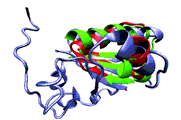Department of Chemistry
Document Type
Article
Date of this Version
9-2008
Citation
J Fluor Chem. 2008 September ; 129(9): 731–742. doi:10.1016/j.jfluchem.2008.05.016.
Abstract
On the one hand, owing to its electronegativity, relatively small size, and notable leaving group ability from anionic intermediates, fluorine offers unique opportunities for mechanism-based enzyme inhibitor design. On the other, the “bio-orthogonal” and NMR-active 19-fluorine nucleus allows the bioorganic chemist to follow the mechanistic fate of fluorinated substrate analogues or inhibitors as they are enzymatically processed. This article takes an overview of the field, highlighting key developments along these lines. It begins by highlighting new screening methodologies for drug discovery that involve appropriate tagging of either substrate or the target protein itself with 19Fmarkers, that then report back on turnover and binding, respectively, via an the NMR screen. Taking this one step further, substrate-tagging with fluorine can be done is such a manner as to provide stereochemical information on enzyme mechanism. For example, substitution of one of the terminal hydrogens in phosphoenolpyruvate, provides insight into the, otherwise latent, facial selectivity of C-C bond formation in KDO synthase. Perhaps, most importantly, from the point of view of this discussion, appropriately tailored fluorinated functionality can be used to form to stabilized “transition state analogue” complexes with a target enzymes. Thus, 5-fluorinated pyrimidines, α- fluorinated ketones, and 2-fluoro-2-deoxysugars each lead to covalent adduction of catalytic active site residues in thymidylate synthase, serine protease and glycosidase enzymes, respectively. In all such cases, 19F NMR allows the bioorganic chemist to spectrally follow “transition state analogue” formation. Finally, the use of specific fluorinated functionality to engineer “suicide substrates” is highlighted in a discussion of the development of the α-(2′Z-fluoro)vinyl trigger for amino acid decarboxylase inactivation. Here 19F NMR allows the bioorganic chemist to glean useful partition ratio data directly out of the NMR tube.



Comments
Copyright 2008. Used by permission.